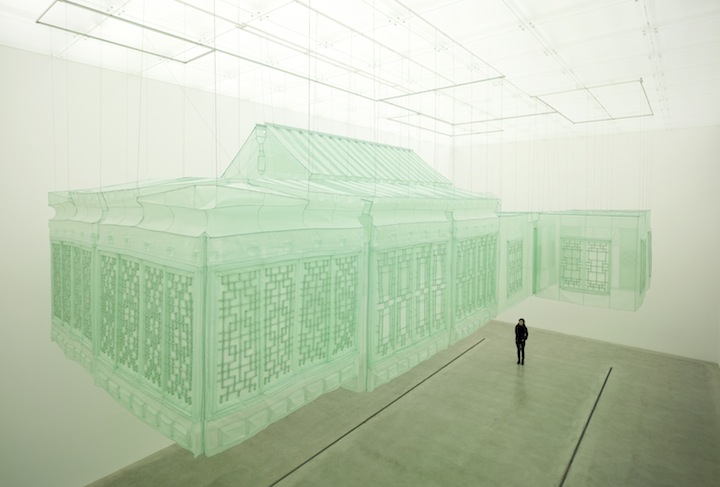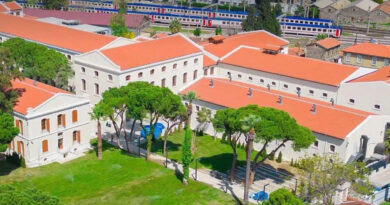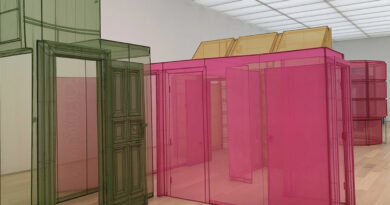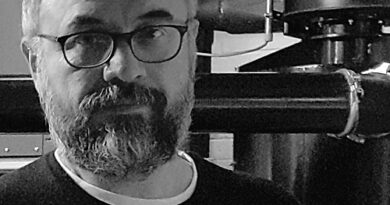do ho suh: home / an imaginary structure of confession chambers
BY GÜLAY YAŞAYANLAR
Do Ho Suh has created himself a niche of permanent exile between Western and Asian cultures; and a unique area of presence for his work with his majestic sculptures of homes that metaphorically reflect a broad internal argument. They reveal the artist’s inner world in light of his thoughts and dream-forms. For this reason, this monumental architecture, which touches upon Suh’s personal history and memories, is a practice of dream-writing that is as homogenous and fragile as it is robust.

Seoul Home/Seoul Home/Kanazawa Home/Beijing Home/Pohang Home/Gwangju Home, 2012-present
silk and stainless steel tubes, 573.62 x 282.28 x 153.94 inches. © Do Ho Suh. Courtesy the artist and Lehmann Maupin, New York, Hong Kong, Seoul, and London. [ https://www.lehmannmaupin.com/artists/do-ho-suh ]
Do Ho Suh’s series of narratives, based on the houses he has lived in across different world cities; have the aspect of weightless, transparent stories shaped in pursuit of different architectural norms.[i] This fantastic conceptual framework, grounded in the innate properties of the idea of home, rests on numerous psychological, historic, cultural codes and public associations. It has a permeable aspect, which relates to traditional Asian architecture with protean structural elements; and questions present-day borders and the concept of the interior. Here, there are no hard, permanent walls. The excessive elements are the reflections of a phantom visage, made temporary through associations with their own traumatic emptiness.
From the beginning, Suh’s fully-scaled, portable and sometimes levitating home/locales have been products of a narrative understanding that re-builds the traces and order of cultural change with each re-telling.
the construction of difference and manifestation
Do Ho Suh’s iconic/monumental homes, full of memories; become potent experiences thanks to a visual language of concepts that enable an infinite spectrum of performances. The resulting locations and architectural elements create a mental experience that awakens the feelings, negates time, and perpetuates a psychological debate of locations. Suh’s houses resemble dream structures made up of mind-expanding, unsettling hollow areas, and confessional spaces. Thus, these sculptural homes are also philosophical elements of memory, psychologically conjoined to an uncanny, majestic, dazzling, and playful narrative style.
Do Ho Suh’s poetic design narrative also joins itself to everyday objects present in the locations it depicts. It reflects the links and conflicts of everyday objects such as radiators, bathtubs, toilet seats, wash basins, showers and cabinets; with everyday life.[ii] By removing them from their everyday locations and contexts; Suh’s deconstructive approach further forces these objects into physically-perceivable, tangible, yet fetishized collaborations with the viewer. For example, the humble radiator becomes an attractive locus thanks to its engagement with colorful nylon strings.[iii] Secluded behind a virgin, translucent veil, the pink radiator becomes an ingrained, romantic object thanks to Suh’s play of distances – a solitary life-form fetishized and emotionally-charged in its graceful translucence. In this manner, the artist metaphorically filters narrative from his delicate sieve of veils, and constructs his own layered stories of compacted memories and layered time.
The contribution provided by these sculptural, deconstructed appendant objects to a memory of repressed time, and a symbolism of locational belonging, is difficult to overlook.
do ho suh / the home as a psychological symbol and image
In Do Ho Suh’s oeuvre, the home is a perfect psychological object that does not allow disorder or destruction; a strength of power and an ironic component that directs the narrative with intimate links to concepts of exile and statelessness. Its construction employs special areas that recall cultural repression of individual memory; and the purposeful divorce of architectural elements from direct function.
The process results in sterile, delicate and lightweight houses that emphasize minor differences and reflect a psychological time-scape of imagery. The sequence of images contained in the structures’ meticulously-made, optimistically-charged transparent walls expresses a wealth of ideas and emotions. These spatial arrangements that question collective relations with reality – are also a stage for experiences of belonging experienced via details such as doorbells, plugs, electric switches and doorknobs.
Perhaps due to the richness of these ingrained allusions, Do Ho Suh dissects and fragments the concept of his houses in order to reveal all their constituents. By presenting us with new spatial possibilities based on an alternative ordering of the exterior and the interior; the artist creates an experience of crossing thresholds.
Do Ho Suh has created himself a niche of permanent exile between Western and Asian cultures; and a unique area of presence for his work with his majestic sculptures of homes that metaphorically reflect a broad internal argument. They reveal the artist’s inner world in light of his thoughts and dream-forms. For this reason, this monumental architecture, which touches upon Suh’s personal history and memories, is a practice of dream-writing that is as homogenous and fragile as it is robust. (Translated by C.M. Kösemen)
Gülay Yaşayanlar, Copyright © 2022 / All Rights Reserved.
Ayrıca bakınız: https://saglamart.com/do-ho-suh-yapibozumcu-bir-kiskirtma-alani-olarak-ev
[i] Do Ho Suh (b. 1962, Seoul, Korea; lives and works in London, United Kingdom) works across various media, creating drawings, film, and sculptural works that confront questions of home, physical space, displacement, memory, individuality, and collectivity. Suh is best known for his fabric sculptures that reconstruct to scale his former homes in Korea, Rhode Island, Berlin, London, and New York. Suh is interested in the malleability of space in both its physical and metaphorical forms, and examines how the body relates to, inhabits, and interacts with that space. He is particularly interested in domestic space and the way the concept of home can be articulated through architecture that has a specific location, form, and history. For Suh, the spaces we inhabit also contain psychological energy, and in his work he makes visible those markers of memories, personal experiences, and a sense of security, regardless of geographic location. [https://www.lehmannmaupin.com/artists/do-ho-suh/biography]
[ii] In the Specimens series, Suh showcases the voids in her life and the elements held within the voids. These pieces of sculpture setups try to convey the emotions that people attach to spaces. This is how Suh describes his own feelings of displacement, characterized by references to his home, either explicitly or implicitly. By isolating these objects, Suh also invites the viewer to rethink their daily interactions with the seemingly mundane item/object. [https://publicdelivery.org/do-ho-suh-specimen/]
Do Ho Suh, Toilet, 2013, polyester fabric, 34 x 150.1 x 76.5 cm, from Specimen Series: 348 west 22nd Street, Apt. New York, NY 10011, USA/ 12 Ekim 2018 – 6 Ocak 2019 | Gordon Contemporary Artists Project Gallery. [https://fristartmuseum.org/exhibition/do-ho-suh-specimens/], Do Ho Suh, Specimen Series: 348 West 22nd Street, APT. New York, NY 10011, USA – Refrigerator, 2013, Polyester fabric, 166.9 x 72.6 x 73.9 cm. Lehmann Maupin Gallery, 14 Kasım 2013- 25 Ocak 2014 Hong Kong 2014. Hong Kong. [https://www.lehmannmaupin.com/exhibitions/do-ho-suh9]
[iii] Do Ho Suh, Radiator, 2013, polyester fabric, 93.5 x 74.7 x 18.3 cm. from Specimen Series: 348 west 22nd street, apt. New York, NY 10011, USA. Do Ho Suh, Scaled Behaviour run On (radiator-10.7.1), 2021, Polyester thread, resin, 118.3 x 96.5 x 38.5 cm © Do Ho Suh. Courtesy the artist and Lehmann Maupin Gallery, New York, Hong Kong, Seoul, and London



